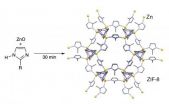(Press-News.org) Anthrax uses a receptor on the surface of cells to inject its lethal toxins. However, the physiological function of this receptor, named Anthrax Toxin Receptor 2a (Antxr2a), remained unknown until now. A team led by Marcos Gonzalez-Gaitan, a professor at the University of Geneva (UNIGE), Switzerland, in collaboration with Gisou van der Goot at EPFL (École Polytechnique Fédérale de Lausanne), reveals that Antxr2a actually plays a role in embryonic development, orienting cell division along a specific plane, which is a prelude to the formation of future tissues and organs. At the cellular level, this receptor exerts traction on the system that allows chromosomes to separate to opposite poles, the mitotic spindle, to position it along the plane of division. These results are presented in the journal Nature Cell Biology.
Anthrax is a particularly virulent germ once a person is infected by inhaling its spores. The severity of symptoms, which affect various organs, is mainly due to bacterial toxins which are lethal to cells. It is by attempting to understand how the bacillus' toxins enter cells that the Antxr2a receptor was discovered. Otherwise, its physiological role would not have been identified at present.
A cap of proteins indicates the plane of division
During animal development, the orientation of cell division along a specific plane is important for the organization of the different tissues and the generation of cellular diversity. This orientation is provided by the position of the mitotic spindle in the cell that is about to divide. This temporary assembly of microtubules forms an actual spindle between opposite poles of the cell in order to guide the migration of each set of chromosomes.
"When the cell receives an external signal to initiate its division, a cascade of biochemical events is launched to transmit the message to the interior of the cell and have it carried out. We knew that an external signal, a protein called Wnt, was necessary to properly position the mitotic spindle, but knew nothing of the intracellular messengers involved," explains Marcos Gonzalez-Gaitan, Professor in the Departments of Biochemistry and Molecular Biology at the University of Geneva.
This has now been accomplished. The scientist and his group have established the complete sequence of intracellular events allowing the mitotic spindle to align itself along the general plane of division. They conducted their experiments on zebrafish embryos, a model system in developmental studies. "Once Wnt binds to the cell membrane, different molecular agents prompt the formation of a layer of filamentous proteins along the cell membrane, at the site of the future plane of division," explains Irinka Castanon, first author of the article.
The anthrax receptor used as a control lever
This internal 'cap' associates itself in turn with the Antxr2a receptors, known to bind the anthrax toxin. The accumulation of these receptors will thus form a second layer, superimposed on the first. Everything is now in place for the final phase: "The Antxr2a receptors recruit in turn 'motor' proteins capable of attaching themselves to the mitotic spindle and pulling it towards the internal cap," states Marcos Gonzalez-Gaitan. Motor proteins probably act by travelling back up along the cap's filaments, allowing the alignment of the spindle with the plane of cell division.
In mammals, the Antxr2a receptor is also involved in the formation and proliferation of blood vessels. "It is therefore possible that the role of this receptor in the orientation of cell division is not restricted solely to embryonic development," states the professor, who is a member of two Swiss National Research Programs: Frontiers in Genetics, and Chemical Biology.
### END
The role of the cellular entry point of anthrax identified
Researchers at the University of Geneva, Switzerland, demonstrate that the receptors that bind the toxin of this bacterium control how cell division is oriented
2012-12-03
ELSE PRESS RELEASES FROM THIS DATE:
New gene-sequencing tools offer clues to highest-risk form of a childhood cancer
2012-12-03
Using powerful gene-analysis tools, researchers have discovered mutations in two related genes, ARID1A and ARID1B, that are involved in the most aggressive form of the childhood cancer neuroblastoma. While these findings do not immediately improve clinical treatments, they identify a novel pathway that is defective in these cancers, a pathway that scientists can now study to develop potential new therapies.
"These gene alterations were not previously known to be mutated in neuroblastoma, and they may significantly advance our knowledge of the underlying biological pathways ...
Genes linked to low birth weight, adult shortness and later diabetes risk
2012-12-03
An international team of genetics researchers has discovered four new gene regions that contribute to low birth weight. Three of those regions influence adult metabolism, and appear to affect longer-term outcomes such as adult height, risk of type 2 diabetes and adult blood pressure.
"This large study adds to the evidence that genes have a strong influence on fetal growth," said one of the co-authors, Struan F.A. Grant, Ph.D., associate director of the Center for Applied Genomics at The Children's Hospital of Philadelphia. "The cumulative effect of the genes is surprisingly ...
Scientists at Scripps Research Institute discover how 2 proteins help keep cells healthy
2012-12-03
LA JOLLA, CA – December 2, 2012 – Scientists at The Scripps Research Institute (TSRI) have determined how two proteins help create organelles, or specialized subunits within a cell, that play a vital role in maintaining cell health. This discovery opens the door for research on substances that could interfere with the formation of these organelles and lead to new therapies for cancer.
The study, published online ahead of print on December 2, 2012, by the journal Nature Structural & Molecular Biology, focuses on the structure and function of the two proteins, ATG12 and ...
Scientists find 'bully' genes in common childhood tumor
2012-12-03
In a genome sequencing study of 74 neuroblastoma tumors in children, scientists at the Johns Hopkins Kimmel Cancer Center and the Children's Hospital of Philadelphia (CHOP) found that patients with changes in two genes, ARID1A and ARID1B, survive only a quarter as long as patients without the changes. The discovery could eventually lead to early identification of patients with aggressive neuroblastomas who may need additional treatments.
Neuroblastomas affect nerve tissue throughout the body and are the most common, non-blood cancer in children. "These cancers have a ...
Origin of intelligence and mental illness linked to ancient genetic accident
2012-12-03
Scientists have discovered for the first time how humans – and other mammals – have evolved to have intelligence.
Researchers have identified the moment in history when the genes that enabled us to think and reason evolved.
This point 500 million years ago provided our ability to learn complex skills, analyse situations and have flexibility in the way in which we think.
Professor Seth Grant, of the University of Edinburgh, who led the research, said: "One of the greatest scientific problems is to explain how intelligence and complex behaviours arose during evolution." ...
Childhood trauma leaves mark on DNA of some victims
2012-12-03
This press release is available in German.
Abused children are at high risk of anxiety and mood disorders, as traumatic experience induces lasting changes to their gene regulation. Scientists from the Max Planck Institute of Psychiatry in Munich have now documented for the first time that genetic variants of the FKBP5 gene can influence epigenetic alterations in this gene induced by early trauma. In individuals with a genetic predisposition, trauma causes long-term changes in DNA methylation leading to a lasting dysregulation of the stress hormone system. As a result, ...
A shock to pollution in chemistry
2012-12-03
Solvents are omnipresent in the chemical industry, and are a major environmental and safety concern. Therefore the large interest in mechanochemistry: an energy-efficient alternative that avoids using bulk solvents and uses high-frequency milling to drive reactions. Milling is achieved by the intense impact of steel balls in a rapidly moving jar, which hinders the direct observation of underlying chemistry. Scientists have now for the first time studied a milling reaction in real time, using highly penetrating X-rays to observe the surprisingly rapid transformations as ...
Cell surface transporters exploited for cancer drug delivery
2012-12-03
CAMBRIDGE, Mass. (December 2, 2012) –Whitehead Institute scientists report that certain molecules present in high concentrations on the surfaces of many cancer cells could be exploited to funnel lethal toxic molecules into the malignant cells. In such an approach, the overexpression of specific transporters could be exploited to deliver toxic substances into cancer cells.
Although this finding emerges from the study of a single toxic molecule and the protein that it transports, Whitehead Member David Sabatini says this phenomenon could be leveraged more broadly.
"Our ...
Surprising results from study of non-epileptic seizures
2012-12-03
MAYWOOD, Il. - A Loyola University Medical Center neurologist is reporting surprising results of a study of patients who experience both epileptic and non-epileptic seizures.
Non-epileptic seizures resemble epileptic seizures, but are not accompanied by abnormal electrical discharges. Rather, these seizures are believed to be brought on by psychological stresses.
Dr. Diane Thomas reported that 15.7 percent of hospital patients who experienced non-epileptic seizures also had epileptic seizures during the same hospital stay. Previous studies found the percentage of such ...
A better way to make chemicals?
2012-12-03
Bulk solvents, widely used in the chemical industry, pose a serious threat to human health and the environment. As a result, there is growing interest in avoiding their use by relying on "mechanochemistry" – an energy-efficient alternative that uses high-frequency milling to drive reactions. Because milling involves the intense impact of steel balls in rapidly moving jars, however, the underlying chemistry is difficult to observe.
Now, for the first time, scientists have studied a milling reaction in real time, using highly penetrating X-rays to observe the surprisingly ...
LAST 30 PRESS RELEASES:
Fungus turns bark beetles’ defenses against them
There are new antivirals being tested for herpesviruses. Scientists now know how they work
CDI scientist, colleagues author review of global burden of fungus Candida auris
How does stroke influence speech comprehension?
B cells transiently unlock their plasticity, risking lymphoma development
Advanced AI dodel predicts spoken language outcomes in deaf children after cochlear implants
Multimodal imaging-based cerebral blood flow prediction model development in simulated microgravity
Accelerated streaming subgraph matching framework is faster, more robust, and scalable
Gestational diabetes rose every year in the US since 2016
OHSU researchers find breast cancer drug boosts leukemia treatment
Fear and medical misinformation regarding risk of progression or recurrence among patients with breast cancer
Glucagonlike peptide-1 receptor agonists and asthma risk in adolescents with obesity
Reviving dormant immunity: Millimeter waves reprogram the immunosuppressive microenvironment to potentiate immunotherapy without obvious side effects
Safety decision-making for autonomous vehicles integrating passenger physiological states by fNIRS
Fires could emit more air pollution than previously estimated
A new way to map how cells choose their fate
Numbers in our sights affect how we perceive space
SIMJ announces global collaborative book project in commemoration of its 75th anniversary
Air pollution exposure and birth weight
Obstructive sleep apnea risk and mental health conditions among older adults
How talking slows eye movements behind the wheel
The Ceramic Society of Japan’s Oxoate Ceramics Research Association launches new international book project
Heart-brain connection: international study reveals the role of the vagus nerve in keeping the heart young
Researchers identify Rb1 as a predictive biomarker for a new therapeutic strategy in some breast cancers
Survey reveals ethical gaps slowing AI adoption in pediatric surgery
Stimulant ADHD medications work differently than thought
AI overestimates how smart people are, according to HSE economists
HSE researchers create genome-wide map of quadruplexes
Scientists boost cell "powerhouses" to burn more calories
Automatic label checking: The missing step in making reliable medical AI
[Press-News.org] The role of the cellular entry point of anthrax identifiedResearchers at the University of Geneva, Switzerland, demonstrate that the receptors that bind the toxin of this bacterium control how cell division is oriented



